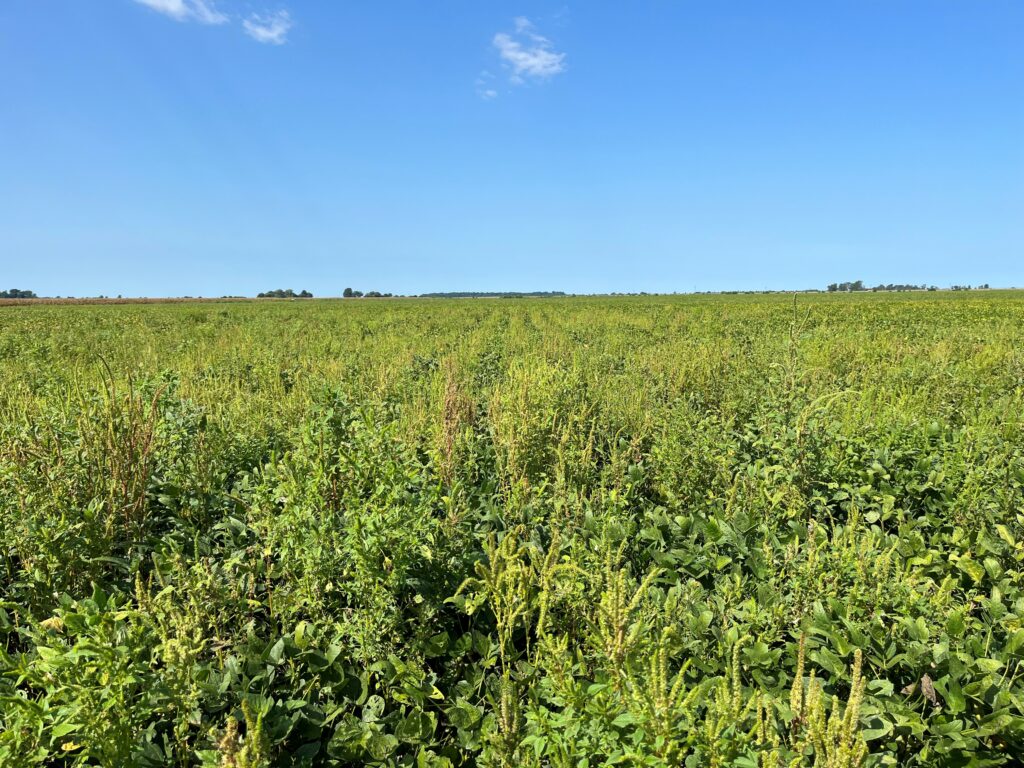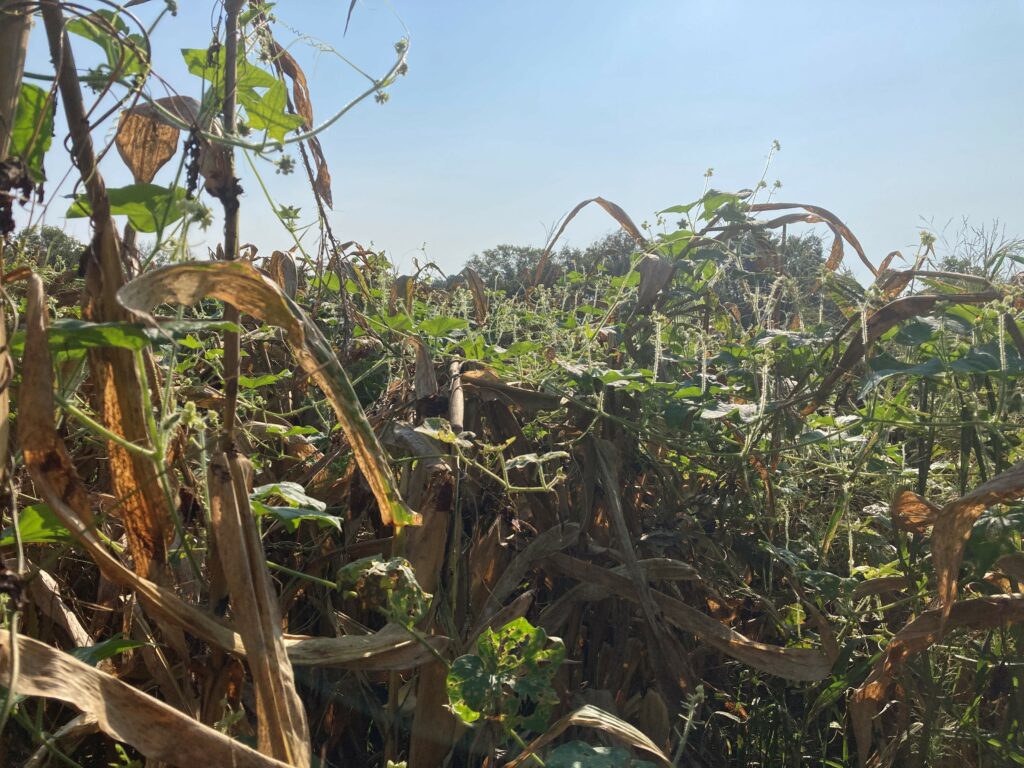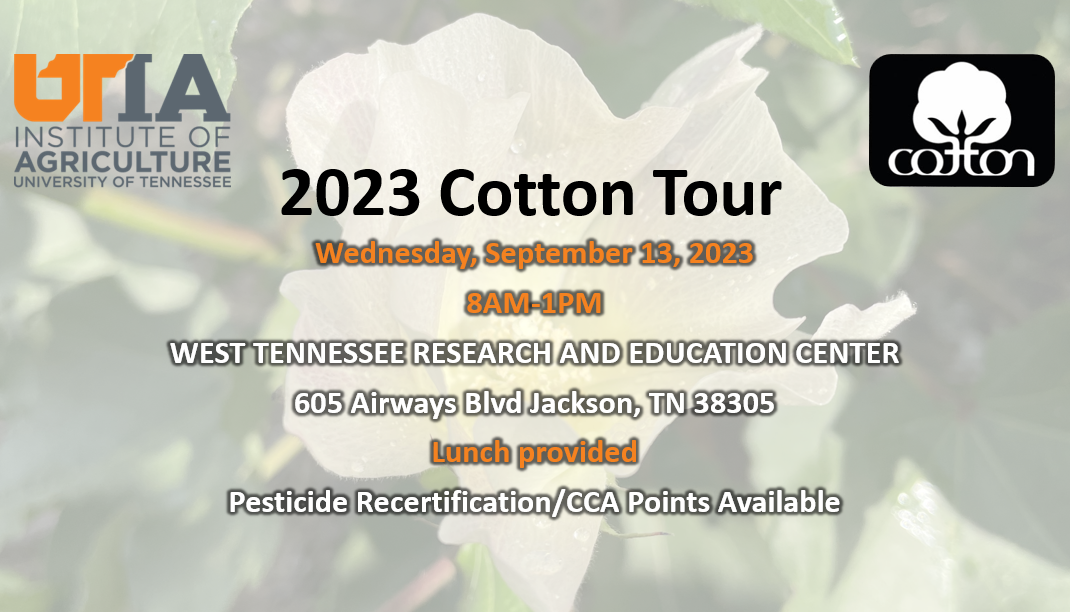As most Tennessee soybeans are entering their mid-late reproduction growth stages, some symptoms of diseases caused by soil-borne pathogens may be beginning to show up in our fields, particularly sudden death syndrome this year. The issue with diagnosing diseases caused by soil-borne pathogens is that they often exhibit very similar symptomology to each other. However, there are certain indicators that can help you differentiate between these diseases and help you make the best management decisions moving forward. Continue reading
Recent Updates
A Step Back on Palmer Amaranth Control

Driving across West Tennessee last week it is very apparent we have taken a step backward on Palmer amaranth control. Many fields that looked clean from the road in late July are now showing large Palmer amaranth escapes. Upon closer inspection the pigweed escapes are at least partially affected by the dicamba applications which resulted in them staying hidden from the road until the last couple of weeks. Continue reading
Best Time to Control Perennial Vines is Now

Practically every September some growers are dismayed at the vine infestations present at corn harvest. Often, these weed infestations emerged after PRE applied or early POST applied herbicides had played out. They grew very little until August and as the corn dried down and light became more available those established weeds started rapidly growing.
The vines in question are often perennial in growth habit like honeyvine milkweed, redvine, hedge bindweed and burcucumber. There is really no in-crop option that will provide good perennial vine control. The best one can achieve with an in-crop application is enough vine suppression to minimize harvest issues.
Perennial vines are best controlled with herbicide applications after harvest. The most consistent tactic is to allow the vines to grow back for a week or so after harvest and then apply dicamba and/or 2,4-D. Tank mixing in glyphosate can also increase vine control. For best results go with rates at the higher end of the labels. Continue reading
REMINDER: Cotton Tour THIS Wednesday, Sept 13th @ 8AM

The 2023 Cotton Tour will be held next Wednesday, Sept. 13, 2023 at 8AM at the West Tennessee Research and Education Center (605 Airways Blvd, Jackson, TN 38305). Pesticide recertification and CCA points will be available. Tulum will be catering lunch for us.
I’m very happy to report the slate of speakers includes Dr. Jake McNeal, our new Corn and Soybean Specialist who started earlier this spring. He will make a few comments about a few of the research trials he has established at WTREC and some preliminary results from a soybean desiccation study. The agenda for the event can be found by following this link. Look forward to seeing you there!
Ryegrass and Poa Management in Wheat
The two best fall-applied options for ryegrass and poa in wheat are Anthem Flex and Zidua. Pyroxasulfone is providing the grass control in both these herbicides. Anthem Flex can be applied as a true PRE right behind the press wheel. Keep in mind there is some chance of wheat injury from this new use pattern if a rain occurs shortly after planting. As such, if rain is in the forecast wait and apply it later as a delayed PRE or early POST. Continue reading
Reminder: Soybean Disease Field Day Sept. 12th
 Wondering what’s been making your soybeans sickly? Come to The University of Tennessee Soybean Disease Field Day, held Tuesday, Sept. 12th, at the Milan Research and Education Center. Registration will be from 8:30-9:00 AM with the tour beginning at 9 AM and concluding with a box lunch. Preregistration is not required. Pesticide re-certification and CCA points will be available. Continue reading
Wondering what’s been making your soybeans sickly? Come to The University of Tennessee Soybean Disease Field Day, held Tuesday, Sept. 12th, at the Milan Research and Education Center. Registration will be from 8:30-9:00 AM with the tour beginning at 9 AM and concluding with a box lunch. Preregistration is not required. Pesticide re-certification and CCA points will be available. Continue reading
August 31 Bollworm/Budworm Catches for West TN
| Location | CEW | TBW |
| Hardeman (Bolivar) | 2 | 0 |
| Fayette (Whiteville) | 3 | 0 |
| Fayette (Somerville) | 12 | 0 |
| Shelby (Millington) | 4 | 0 |
| Tipton (Covington) | 3 | 0 |
| Tipton (North) | 3 | 0 |
| Lauderdale (Golddust) | 8 | 0 |
| Haywood(West) | 9 | 0 |
| Haywood (Brownsville) | 15 | 1 |
| Madison (WTREC) | 9 | 0 |
| Madison (North) | 0 | 0 |
| Crockett (Alamo) | 0 | 0 |
| Crockett (Friendship) | 2 | 0 |
| Dyer (King Rd) | 12 | 0 |
| Dyer (Dyersburg) | 1 | 0 |
| Lake (Ridgely) | 12 | 0 |
| Gibson (Trenton) | 30 | 0 |
| Gibson (Milan Rec) | 0 | 0 |
| Carroll (Coleman Farm) | 8 | 0 |
Numbers are consistently going down across West TN and this is the last week for trap catches.
Corn Earworms Showing Up in Soybeans
I’ve received a few calls this week on corn earworms (bollworm/podworm) showing up in fields across Tennessee. UT’s threshold for earworms, in beans, is based on sweep net sampling, crop value and control costs. The table below outlines the threshold based on the above factors.

Crop value is on the left-hand side, control costs are the 3rd row from the top and numbers beneath control costs are earworm numbers per 25 sweeps. The spot price of beans for (8/31) is $13.75 and control costs can vary from $10 to $16, depending on product choice, so the threshold in 25 sweeps would be 5 to 6 earworms per 25 sweeps. As crop price and control cost changes so does the number of earworms in our threshold.
Moths are typically attracted to later planted, more open canopy fields. However, earworms can be found in any stage beans. Insecticide choice depends on a few factors. If earworms are at or near threshold, acephate (0.75 lb/a) plus a pyrethroid is a cheaper option that provides acceptable control. This option runs the risk of flaring other pests (loopers, mites) and fields need to be rechecked 4-5 days after application to makes sure adequate control was achieved. If worms are above threshold safer choices would be Vantacor (1.2 fl oz), Elevest (5.0 fl oz), Besiege (7.0 fl oz), Intrepid Edge (4.0 fl oz) or Blackhawk (2.0 oz). The diamides (Vantacor, Besiege, Elevest) will have the longest residual control but many earworm issues in TN beans are solved after one application.
Another, more nonconvention option is Heligen (1.0 – 1.5 fl oz). Heligen is earworm specific and doesn’t have a fit on every acre. Applications should be initiated on small larvae at half a threshold (typically 2 – 4 larvae in 25 sweeps). Heligen is a virus that spreads throughout the field via infected larvae and requires some patience and knowledge of infection symptomology.
One final note, this product should almost be looked at as a preventative not a curative product. However, worms have to be in the field for the virus to infect the target and replicate causing an epizootic. Large populations of earworms, at or above threshold, need a conventional insecticide.

